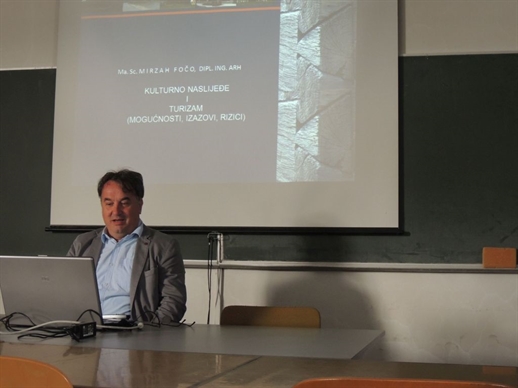Commission to Preserve National Monuments in cooperation with the Faculty of Architecture in Sarajevo marked the International Day of Monuments and sites
4/13/2017

International Day for Monuments and Sites is celebrated every year on 18 April, using a working theme recommended by the Executive Committee of the International Council on Monuments and Sites (ICOMOS) [1]. This year, the theme is "Cultural heritage and sustainable tourism". The theme was chosen in a line with the International year of sustainable tourism for development [2], and the Agenda 2030 for sustainable development, including the Goals of sustainable development [3].
On Monday 13 April, on the eve of the celebration of the International Day, the Commission to Preserve National Monuments in cooperation with the Faculty of Architecture in Sarajevo organized a lecture for students of IV year.
Member of the Commission to Preserve National Monuments and a professor at the Faculty of Architecture in Sarajevo, prof. Amir Pasic, PhD, presented to the students a significance of this year's theme in the broadest context, while the associate professor, assistant prof. Lemja Chabbouh-Akšamija, PhD, held lectures on the phenomenon of traditions authenticity, origin and integrity of the space.
The lecture entitled "The heritage and tourism" was held by Mirzah Foco, the executive officer of the Commission to Preserve National Monuments.
This kind of cooperation with universities, both in BiH and abroad, presents a part of the activities carried out by the Commission in order to promote cultural and historical heritage of BiH and its preservation.
***
Issues related to rehabilitation, reconstruction and revitalization have a central role in sustainable tourism and decision-making with regard the protection of authenticity. Questions related to the methods of preserving the architectural heritage, historic townscapes and cultural landscapes, and a traditional way of life so-called "Living heritage" are too comprehensive and should be taken into consideration when planning for sustainable tourism. Tourism is derived from space and unfolds itself in that same space thus affecting the transformation of the space.
The cultural heritage has to be developed in a sense of tourism, and shaped in that terms but in accordance with the sustainable development, which shall not in any possible manner cause a damage to the site but contribute to rehabilitation and preservation. The concept of sustainable tourism is based on three supporting pillars of sustainable development, which were defined and recommended by the World Tourism Organization, and they are as follows: the sustainability of economic, cultural and natural environment.
When it comes to sustainability, so-called cultural tourism is the most mentioned as beneficial and useful for sustainable development, whereas cultural heritage remains there for future generations too. In this way, the relationship has been established between tourism and the use of history, tradition, culture and cultural heritage for commercial purposes in the sense of positive promotion of culture and cultural heritage.
Therefore, this relationship between the culture and tourism brings extensive connectivity and mutual benefit, which have been confirmed by creating extra income to the benefit of both activities, and has as a result sustainability and promotion of cultural resources. Cultural tourism protects cultural heritage which is being put in the function of various music, dance or theater events. In that manner, cultural property is used for cultural purposes or events, which are the primary reasons for the visit. The significance of cultural heritage, as a tourist attraction, is that it provides an opportunity to attract visitors, and therefore its importance is unambiguous.
Tourist should be educated, informed and attracted to the idea of tourism in terms of cultural heritage. They should be interested for the sites they visit, and the story about the responsibility should be imposed, as well as the awareness about the sustainability in general.
[1] International Day for Monuments and Sites has been established by the International Council on Monuments and Sites (ICOMOS) on 18 April 1982, and later was approved by UNESCO in order to raise public awareness of the diversity of the cultural heritage of mankind, its vulnerability and efforts required for its protection and preservation.
[2] United Nations General Assembly declared the year 2017 the International Year of Sustainable Tourism Development.
[3] At the UN summit on Sustainable Development, which was held on 25 September 2015 in New York, more than 150 world leaders adopted a new Agenda 2030 for sustainable development, including the Objectives of sustainable development (Sustainable Development Goals - SDGs), called Let's transform our world: Agenda 2030 for Sustainable Development. Agenda 2030 represents an action plan for people, planet and prosperity, and it has 17 goals for sustainable development in order to eradicate poverty, to fight against inequality and injustice and addressing the climate change.
